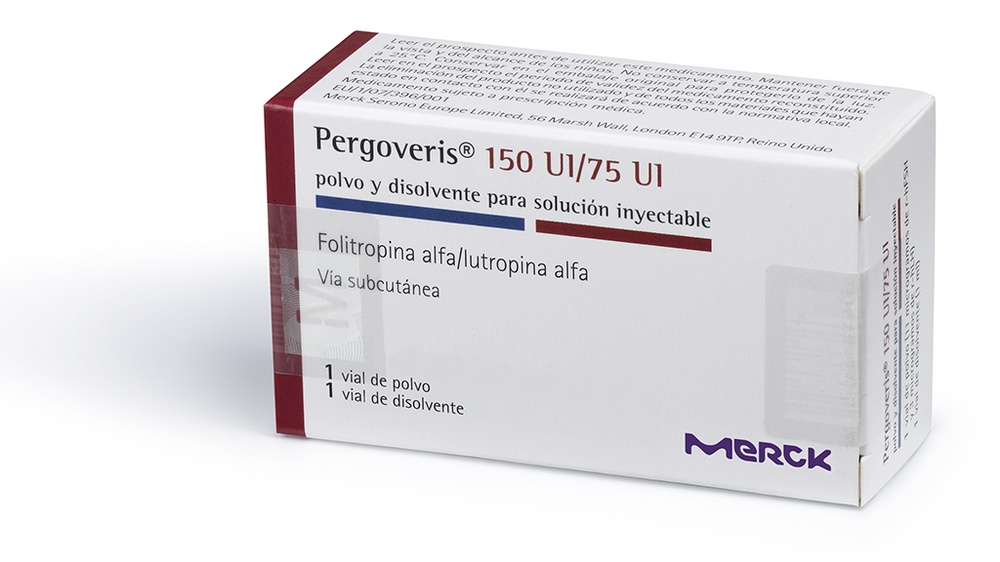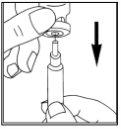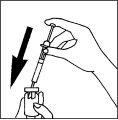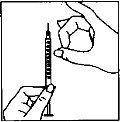

ПЕРГОВЕРИС 150 МЕ/75 МЕ ПОРОШОК И РАСТВОРИТЕЛЬ ДЛЯ ПРИГОТОВЛЕНИЯ ИНЪЕКЦИОННОГО РАСТВОРА


Инструкция по применению ПЕРГОВЕРИС 150 МЕ/75 МЕ ПОРОШОК И РАСТВОРИТЕЛЬ ДЛЯ ПРИГОТОВЛЕНИЯ ИНЪЕКЦИОННОГО РАСТВОРА
Введение
Инструкция: информация для пользователя
Перговерис 150 МЕ/75 МЕ порошок и раствор для приготовления раствора для инъекции
фоллитропин альфа/лютеинизирующий гормон альфа
Прочитайте внимательно всю инструкцию перед началом использования этого препарата, поскольку она содержит важную информацию для вас.
- Сохраните эту инструкцию, поскольку вам может потребоваться перечитать ее.
- Если у вас есть какие-либо вопросы, проконсультируйтесь с вашим врачом, фармацевтом или медсестрой.
- Этот препарат назначен вам исключительно, и не передавайте его другим людям, даже если у них такие же симптомы, как у вас, поскольку это может нанести им вред.
- Если вы испытываете побочные эффекты, проконсультируйтесь с вашим врачом, фармацевтом или медсестрой, даже если это побочные эффекты, которые не указаны в этой инструкции. См. раздел 4.
Содержание инструкции
- Что такое Перговерис и для чего он используется
- Что вам нужно знать перед началом использования Перговериса
- Как использовать Перговерис
- Возможные побочные эффекты
- Хранение Перговериса
- Содержание упаковки и дополнительная информация
1. Что такое Перговерис и для чего он используется
Что такое Перговерис
Перговерис содержит два различных активных вещества, называемых "фоллитропин альфа" и "лютеинизирующий гормон альфа". Оба они принадлежат к семейству гормонов, называемых "гонадотропинами", которые участвуют в репродукции и фертильности.
Для чего используется Перговерис
Этот препарат используется для стимуляции развития фолликулов (каждый из которых содержит ооцит) в яичниках с целью помочь вам забеременеть. Он предназначен для использования у взрослых женщин (18 лет и старше) с низкими уровнями (тяжелым дефицитом) "фолликулостимулирующего гормона" (ФСГ) и "лютеинизирующего гормона" (ЛГ). Обычно эти женщины являются бесплодными.
Как действует Перговерис
Активные вещества Перговериса являются копиями натуральных гормонов ФСГ и ЛГ. В организме:
- ФСГ стимулирует производство ооцитов
- ЛГ стимулирует высвобождение ооцитов.
Заменяя отсутствующие гормоны, Перговерис позволяет женщинам с низкими уровнями ФСГ и ЛГ развить фолликул, из которого будет высвобождена ооцит после инъекции гормона "гонадотропин корионический человека (хГ)". Это помогает женщинам забеременеть.
2. Что вам нужно знать перед началом использования Перговериса
Перед началом лечения должно быть оценено ваше фертильность и фертильность вашего партнера опытным врачом в лечении бесплодия.
Не используйте Перговерис:
- если вы аллергичны к фолликулостимулирующему гормону (ФСГ), лютеинизирующему гормону (ЛГ) или любому другому компоненту этого препарата (перечисленному в разделе 6).
- если у вас есть опухоль мозга (в гипоталамусе или гипофизе).
- если у вас есть большие яичники или жидкостные образования в яичниках (овариальные кисты) неизвестного происхождения.
- если у вас есть необъяснимое вагинальное кровотечение.
- если у вас есть рак яичников, матки или молочной железы.
- если у вас есть состояние, которое делает невозможным нормальную беременность, такое как преждевременная менопауза, аномалии половых органов или доброкачественные опухоли матки.
Не используйте этот препарат, если любое из этих условий применяется к вам. Если вы не уверены, проконсультируйтесь с вашим врачом, фармацевтом или медсестрой перед началом использования этого препарата.
Предостережения и меры предосторожности
Проконсультируйтесь с вашим врачом, фармацевтом или медсестрой перед началом использования Перговериса.
Порфирия
Проконсультируйтесь с вашим врачом перед началом лечения, если вы или любой член вашей семьи страдает порфирией (неспособностью разрушать порфирины, которая может передаваться от родителей к детям).
Немедленно сообщите вашему врачу, если:
- ваша кожа становится хрупкой и легко образуются пузыри, особенно в областях, часто подвергающихся воздействию солнца.
- у вас есть боль в животе, руках или ногах.
В этих случаях ваш врач может рекомендовать вам прервать лечение.
Синдром гиперстимуляции яичников (СГЯ)
Этот препарат стимулирует ваши яичники, что увеличивает риск развития синдрома гиперстимуляции яичников (СГЯ). Это происходит, когда ваши фолликулы развиваются слишком сильно и превращаются в крупные кисты. Если у вас есть боль в области таза, быстрый набор веса, тошнота или рвота или затруднение дыхания, немедленно проконсультируйтесь с вашим врачом, который может порекомендовать вам прервать лечение (см. в разделе 4, в "Побочные эффекты").
В случае, если вы не овулируете и если вы соблюдаете рекомендуемую дозу и схему приема, тяжелый СГЯ менее вероятно произойдет. Лечение Перговерисом редко вызывает тяжелый СГЯ. Это более вероятно, если препарат, используемый для окончательной фолликулярной матурации (содержащий гонадотропин корионический человека, хГ), вводится (см. подробности в разделе 3, в "Как использовать"). В случае развития СГЯ ваш врач может не назначать вам хГ в этом цикле лечения и порекомендовать вам воздержаться от полового акта или использовать барьерный метод контрацепции в течение как минимум 4 дней.
Ваш врач обеспечит тщательный контроль овариальной реакции с помощью ультразвука и анализов крови (определения эстрадиола) до и во время лечения.
Многоплодная беременность
Если вы используете Перговерис, у вас есть более высокий риск забеременеть несколькими детьми одновременно ("многоплодная беременность", обычно двойня) по сравнению с естественной беременностью. Многоплодная беременность может вызвать медицинские осложнения для вас и ваших детей. Вы можете снизить риск многоплодной беременности, используя правильную дозу Перговериса в правильное время.
Чтобы минимизировать риск многоплодной беременности, рекомендуется проводить ультразвук и анализы крови.
Аборт
Если вы подвергаетесь стимуляции яичников для производства ооцитов, вероятность аборта выше, чем в среднем у женщин.
Внематочная беременность
Женщины, которые когда-либо страдали блокировкой или повреждением фаллопиевых труб (трубной болезнью), имеют риск беременности с имплантацией эмбриона вне матки (внематочная беременность). Это так, как при естественной беременности, так и при беременности, достигнутой с помощью методов лечения бесплодия.
Проблемы со свертываемостью крови (тромбоэмболические эпизоды)
Проконсультируйтесь с вашим врачом перед началом использования Перговериса, если вы или любой член вашей семьи когда-либо страдал тромбами крови в ноге или легких, инфарктом миокарда или инсультом. Вы можете иметь более высокий риск тяжелых тромбов или ухудшения существующих тромбов при лечении Перговерисом.
Опухоли половых органов
Были сообщения об опухолях яичников и других половых органах, как доброкачественных, так и злокачественных, у женщин, подвергшихся множественным схемам лечения бесплодия.
Аллергические реакции
Были сообщения о единичных случаях не тяжелых аллергических реакций на Перговерис. Если вы когда-либо имели такую реакцию на подобный препарат, проконсультируйтесь с вашим врачом перед началом использования Перговериса.
Дети и подростки
Перговерис не должен использоваться у детей и подростков моложе 18 лет.
Другие препараты и Перговерис
Сообщите вашему врачу или фармацевту, если вы используете, недавно использовали или можете использовать любой другой препарат.
Не используйте Перговерис с другими препаратами в одной инъекции, за исключением фоллитропина альфа, если это назначено вашим врачом.
Беременность и лактация
Не используйте Перговерис, если вы беременны или в период лактации.
Вождение и использование машин
Не ожидается, что этот препарат повлияет на вашу способность управлять транспортными средствами или работать с машинами.
Перговерис содержит натрий
Перговерис содержит менее 1 ммоль натрия (23 мг) на дозу; это означает, что он практически "не содержит натрия".
3. Как использовать Перговерис
Следуйте точно инструкциям по введению этого препарата, указанным вашим врачом или фармацевтом. В случае сомнений проконсультируйтесь с вашим врачом или фармацевтом.
Использование этого препарата
- Перговерис предназначен для введения под кожу (подкожно). Чтобы минимизировать раздражение кожи, выбирайте разное место инъекции каждый день.
- Он выпускается в виде порошка и жидкости, которые необходимо смешать и использовать немедленно.
- Ваш врач или медсестра научат вас, как приготовить и вводить этот препарат. Они будут наблюдать за вашей первой инъекцией.
- Если они согласны с тем, что вы можете вводить Перговерис безопасно, в дальнейшем вы сможете готовить и вводить препарат самостоятельно дома. Когда вы это делаете, внимательно читайте и следуйте инструкциям, описанным ниже в разделе "Как приготовить и использовать порошок и раствор Перговериса".
Какая доза должна быть использована
Обычная начальная доза составляет 1 флакон Перговериса в день.
- В зависимости от реакции ваш врач может решить добавить ежедневно дозу препарата фоллитропина альфа к инъекции Перговериса. В этом случае обычно доза фоллитропина альфа увеличивается каждые 7 или 14 дней на 37,5-75 МЕ.
- Лечение продолжается до достижения желаемой реакции. Это происходит, когда вы развили подходящий фолликул, оцененный с помощью ультразвука и анализов крови.
- Могут быть необходимы до пяти недель.
Когда будет достигнута желаемая реакция, вам будет введена одноразовая инъекция гонадотропина корионического человека (хГ) через 24-48 часов после последней инъекции Перговериса. Лучшее время для полового акта - это день инъекции хГ и следующий день. Альтернативно также может быть проведена инсеминация или другой метод вспомогательной репродукции, по решению вашего врача.
Если будет достигнута чрезмерная реакция, лечение будет прервано, и вам не будет введена хГ (см. в разделе 2, в "Синдром гиперстимуляции яичников (СГЯ)"). В этом случае ваш врач назначит вам более низкую дозу фоллитропина альфа в следующем цикле лечения.
Как приготовить и использовать порошок и раствор Перговериса
Прежде чем начать приготовление, прочитайте внимательно все инструкции:
Вводите инъекцию в одно и то же время каждый день.
- Вымойте руки и найдите чистое место
- Важно, чтобы ваши руки и материалы, которые вы используете, были как можно более чистыми
- Подходящее место - это чистый стол или поверхность на кухне
- Соберите и расположите все, что вам понадобится
- 1 флакон, содержащий порошок Перговериса
- 1 флакон, содержащий воду для инъекций (растворитель)
Не поставляется в упаковке:
- 2 ватных шарика, смоченных в спирте
- 1 пустая шприц для инъекции
- 1 игла для приготовления
- 1 тонкая игла для инъекции под кожу
- контейнер для острых предметов для безопасной утилизации стеклянных флаконов и игл
- Приготовление раствора
|
|
|
|
- Приготовление шприца для инъекции
|
|
- Введение дозы
|
|
- После инъекции
Утилизируйте все материалы: после завершения инъекции немедленно утилизируйте все иглы и пустые флаконы в контейнер для острых предметов. Любая неиспользованная часть раствора должна быть утилизирована.
Если вы используете больше Перговериса, чем необходимо
Неизвестны эффекты передозировки Перговериса; однако, можно ожидать, что произойдет СГЯ. Тем не менее, это произойдет только в случае, если будет введена хГ (см. в разделе 2, в "Синдром гиперстимуляции яичников (СГЯ)").
Если вы пропустили использование Перговериса
Не используйте двойную дозу, чтобы компенсировать пропущенные дозы. Свяжитесь с вашим врачом.
Если у вас есть какие-либо другие вопросы об использовании этого препарата, проконсультируйтесь с вашим врачом, фармацевтом или медсестрой.
4. Возможные побочные эффекты
Как и все препараты, этот препарат может вызывать побочные эффекты, хотя не все люди испытывают их.
Более серьезные побочные эффекты
Проконсультируйтесь с вашим врачом немедленно, если вы заметите любой из следующих побочных эффектов. Врач может сказать вам, чтобы вы прекратили использовать Перговерис.
Аллергические реакции
Аллергические реакции, такие как кожная сыпь, покраснение кожи, пузыри, отек лица с затруднением дыхания, иногда могут быть тяжелыми. Этот побочный эффект очень редок.
Синдром гиперстимуляции яичников (СГЯ)
- Боль в области таза, сопровождаемая тошнотой или рвотой. Это могут быть симптомы синдрома гиперстимуляции яичников (СГЯ). Возможно, ваши яичники отреагировали чрезмерно на лечение и развились крупные кисты или жидкостные образования (см. в разделе 2, в "Синдром гиперстимуляции яичников (СГЯ)"). Этот побочный эффект часто встречается. Если это произойдет с вами, ваш врач должен как можно скорее осмотреть вас.
- СГЯ может ухудшиться с явным увеличением размера яичников, снижением производства мочи, набором веса, затруднением дыхания и/или возможным накоплением жидкости в брюшной полости или в груди. Этот побочный эффект не часто встречается (может повлиять до 1 из 100 человек).
- Осложнения СГЯ, такие как скручивание яичника или тромбоз, встречаются очень редко (могут повлиять до 1 из 1000 человек).
- Тяжелые проблемы со свертываемостью крови (тромбоэмболические эпизоды), обычно с тяжелым СГЯ, встречаются очень редко. Это может вызвать боль в груди, чувство нехватки воздуха, инсульт или инфаркт миокарда. В редких случаях это также может произойти независимо от СГЯ (см. в разделе 2, в "Проблемы со свертываемостью крови (тромбоэмболические эпизоды)").
Другие побочные эффекты
Очень часто (могут повлиять более 1 из 10 человек)
- жидкостные образования в яичниках (овариальные кисты)
- головная боль
- местные реакции в месте инъекции, такие как боль, зуд, синяки, отек или раздражение.
Часто (могут повлиять до 1 из 10 человек)
- диарея
- боль в груди
- тошнота или рвота
- боль в животе или области таза
- спазмы или растяжение живота
Очень редко (могут повлиять до 1 из 10 000 человек)
- астма может ухудшиться.
Сообщение о побочных эффектах
Если вы испытываете любой побочный эффект, проконсультируйтесь с вашим врачом, фармацевтом или медсестрой, даже если это возможные побочные эффекты, которые не указаны в этой инструкции. Вы также можете сообщить об этом напрямую через национальную систему уведомления, включенную в Приложение V. Сообщая о побочных эффектах, вы можете внести свой вклад в предоставление более полной информации о безопасности этого препарата.
5. Хранение Перговериса
Хранить это лекарство в недоступном для детей месте.
Не используйте это лекарство после даты истечения срока годности, указанной на флаконах и на упаковке после CAD. Дата истечения срока годности - последний день указанного месяца.
Не хранить при температуре выше 25 ºC. Хранить в оригинальной упаковке для защиты от света.
Лекарство должно быть введено сразу после восстановления.
Не используйте Перговерис, если вы заметили видимые признаки порчи.
Восстановленный раствор не должен быть введен, если он содержит частицы или не является прозрачным.
Лекарства не должны быть выброшены в канализацию или в мусор. Спросите у вашего фармацевта, как избавиться от упаковок и лекарств, которые вам больше не нужны. Таким образом, вы поможете защитить окружающую среду.
6. Содержимое упаковки и дополнительная информация
Состав Перговериса
Активные вещества - фоллитропина альфа и лутропина альфа.
- Один флакон содержит 150 МЕ фоллитропины альфа (эквивалентно 11 микрограммам) и 75 МЕ лутропины альфа (эквивалентно 3 микрограммам).
- После восстановления каждая мл раствора содержит 150 МЕ фоллитропины альфа и 75 МЕ лутропины альфа на миллилитр.
Другие компоненты:
- Сахароза, дигидрат дигидrogenфосфата дисодия, моногидрат дигидrogenфосфата натрия, метионин и полисорбат 20, а также концентрированная фосфорная кислота и гидроксид натрия для коррекции pH.
Вид продукта и содержимое упаковки
- Перговерис выпускается в виде порошка и растворителя для инъекционного раствора.
- Порошок представляет собой лиофилизированную таблетку белого или бледно-белого цвета в стеклянном флаконе с пробкой из бромобутиловой резины, содержащей 150 МЕ (эквивалентно 11 микрограммам) фоллитропины альфа и 75 МЕ (эквивалентно 3 микрограммам) лутропины альфа.
- Растворитель представляет собой прозрачную и бесцветную жидкость в стеклянном флаконе, содержащем 1 мл воды для инъекционных препаратов.
- Перговерис выпускается в упаковках, содержащих 1, 3 и 10 флаконов порошка вместе с тем же количеством флаконов растворителя (1, 3 и 10 флаконов). Возможно, не все размеры упаковок будут продаваться.
Владелец разрешения на маркетинг
Merck Europe B.V., Gustav Mahlerplein 102, 1082 MA Amsterdam, Нидерланды
Производитель
Merck Serono S.p.A, Via delle Magnolie 15 (промышленная зона), 70026 Modugno (Бари), Италия
Дата последнего обновления этой инструкции: {MM/AAAA}.
Другие источники информации
Подробная информация о этом лекарстве доступна на сайте Европейского агентства по лекарственным средствам: http://www.ema.europa.eu.
- Страна регистрации
- Активное вещество
- Требуется рецептДа
- Производитель
- Информация носит справочный характер и не является медицинской рекомендацией. Перед приемом любых препаратов проконсультируйтесь с врачом. Oladoctor не несет ответственности за медицинские решения, принятые на основе этого контента.
- Аналоги ПЕРГОВЕРИС 150 МЕ/75 МЕ ПОРОШОК И РАСТВОРИТЕЛЬ ДЛЯ ПРИГОТОВЛЕНИЯ ИНЪЕКЦИОННОГО РАСТВОРАФорма выпуска: ИНЪЕКЦИОННЫЙ РАСТВОР, 300 МЕ/150 МЕАктивное вещество: combinationsПроизводитель: Merck Europe B.V.Требуется рецептФорма выпуска: ИНЪЕКЦИОННЫЙ РАСТВОР, 450 МЕ/225 МЕАктивное вещество: combinationsПроизводитель: Merck Europe B.V.Требуется рецептФорма выпуска: ИНЪЕКЦИОННЫЙ РАСТВОР, 900 МЕ/450 МЕАктивное вещество: combinationsПроизводитель: Merck Europe B.V.Требуется рецепт
Аналоги ПЕРГОВЕРИС 150 МЕ/75 МЕ ПОРОШОК И РАСТВОРИТЕЛЬ ДЛЯ ПРИГОТОВЛЕНИЯ ИНЪЕКЦИОННОГО РАСТВОРА в других странах
Лучшие аналоги с тем же действующим веществом и терапевтическим эффектом.
Аналог ПЕРГОВЕРИС 150 МЕ/75 МЕ ПОРОШОК И РАСТВОРИТЕЛЬ ДЛЯ ПРИГОТОВЛЕНИЯ ИНЪЕКЦИОННОГО РАСТВОРА в Ukraine
Врачи онлайн по ПЕРГОВЕРИС 150 МЕ/75 МЕ ПОРОШОК И РАСТВОРИТЕЛЬ ДЛЯ ПРИГОТОВЛЕНИЯ ИНЪЕКЦИОННОГО РАСТВОРА
Консультация по дозировке, побочным эффектам, взаимодействиям, противопоказаниям и продлению рецепта на ПЕРГОВЕРИС 150 МЕ/75 МЕ ПОРОШОК И РАСТВОРИТЕЛЬ ДЛЯ ПРИГОТОВЛЕНИЯ ИНЪЕКЦИОННОГО РАСТВОРА – по решению врача и с учетом местных правил.









